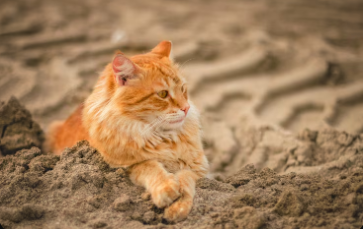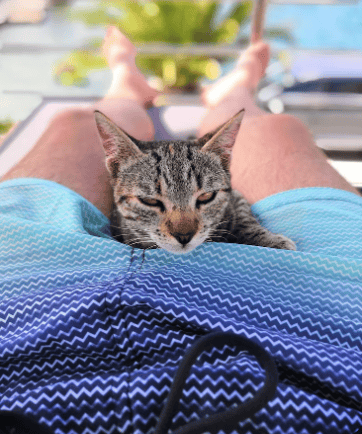Have you ever paid attention to your cat lying in a sunny patch, completely entranced by the sun? It’s one of the most charming yet mysterious behaviours cats possess-sunbathing like little furry monarchs. Be it a warm bit of carpet, a glowing windowsill, or even the top of a car hood, whatever it is, they will instinctively gravitate towards the sun. But what is it? Is it the comfort, or is there something else cooking?
Cats follow their habits, and thus, owners have puzzled over the reason they love the sunlight for many generations. Like humans sunbathe for Vitamin D, cats have their reasons. Their own survival instinct, biology, and even from that, psychology; these aren’t for sunbathing.

The Science Behind Cats Basking in the Sun
Internally, thermoregulation is at the heart of a cat’s ritual sunbathing: a cat’s ability to maintain a stable body temperature. They are warm-blooded mammals, hence they will naturally maintain their body heat; yet, the size and slim build make them lose warmth faster than larger animals. That is why you might find them under blankets, stuffed into piles of laundry, or chasing down any sunbeam in the house.
The normal average body temperature of a cat stays between 100.5 degrees Fahrenheit and 102.5 degrees Fahrenheit (38 and 39.2 degrees Centigrade), at which point maintenance surprisingly requires quite an amount of energy. By basking in the sun, cats allow outside warmth to do a portion of the heavy work in conserving energy that would otherwise have been spent in heat generation internally. Think of it as nature’s way of letting them “charge their batteries” without burning extra fuel.
Cats and Their Craving For Warmth
So if you have ever wondered why a cat prefers to sleep with the laptop, lie on freshly laundered clothes, or curl up in the tiniest sunlit corner of a room, it is pretty simple: warmth. More than most pets, cats have that craving, so it has much to do with the way their biology works.
Unlike humans, cats have fewer receptors of heat in their skin, meaning that they tolerate and appreciate even warmer surface temperatures. That’s why a spot that feels too hot for humans could turn out to be the best nap zone for them. Well, they are not just being dramatic when they sprawl in a sunbeam; they really need and enjoy the warmth.
Vitamin D vs. Cats: Myths and Realities
One such fairly common myth associated with sunbathing is that it somehow allows cats to take in Vitamin D, similar to humans. To this end, it stands as a rational-sounding myth that does not happen to be the case. People synthesise Vitamin D in their bodies via their skin in the event of exposure to sunlight. Such is not the case with cats.
Cats are fed their Vitamin D through their diet, heavily from proteins derived from animals and cat-specialised foods. They don’t produce or store it from sunshine, so they serve entirely different purposes for basking.
Comfort and Relaxation
Sunbathing is like the purest definition of tranquillity for cats. They will stretch, purr, then roll onto their backs to bask in the glow they hugely trust their environment with. There is, however, more than just that concerning the physical; there is an immense measure of psychological comfort that sunbathing provides for cats.
Much like how humans feel relaxed after lounging out on the beach or sitting by a sunny window, for cats, the sun contributes to a lowering of stress and anxiety, with a glow energising the feeling. It relaxes tensions and generally enhances moods.

Sunbathing as a Predatory Instinct
Indeed, one looks at their pampered indoor cat lounging in sunshine today. One must admit, instinct with it from that point isn’t necessarily traceable back to the hunting instincts that the felines exhibit in the wild. But make no mistake about it: the behaviour has a real evolutionary legacy connected to predatory instincts, a sun-warmed cat, wild or tame, tends to be an instinctual hunter that expends most of its energy in a short burst, rather than in prolonged chases like a dog or wolf. This is an energy-consuming technique and should devote as much energy as possible to saving it whenever it can.
Muscle Sun-warmed. But because not much effort goes into such sunbathing, it saves on calories and keeps the cat in shape for the sudden movements.
Indoor Working-O-Outdoor Cats: A Sunbathing Profile
Depending on whether a cat is an indoor or an outdoor one, the sunbathing kilometres can differ, but in essence, the knack remains the same.
When it comes to sunlight, indoor cats spot small areas of it and try to keep up with the shifting rays as they cross the floors; they jump onto sunlit window sills, or sometimes just lie in the midst of sunlit glow on furniture. Being somewhat restricted in outdoor exposure, these cats constitute every ray of sunshine that enters their house. Sometimes, when sunlight isn’t an option, they choose heat from a radiator or a heated cat mat.
In contrast, outdoor cats are a little freer to bask in the sun’s rays. In a garden, a roof, or a driveway, they generally choose sunny spots; however, instinctively, they prefer elevated and half-sheltered locations for safety reasons. The outdoors subjects these animals to overexposure, dehydration, or even predators, thus keeping them true to their wild counterparts in terms of sunbathing habits.
Interestingly, outdoor cats might sunbathe less because they have more natural ways for heat regulation, like sitting in the shade of trees or chilling in cool grass.
Sun Can Be a Risk for Your Cats
Although there is ample evidence promoting sun exposure as a home remedy considered good for cats, its potential hazards greatly endanger cats prone to long hours of outdoor life. The major issues from too much sun exposure to cats are those of overheating, dehydration, and sunburn.
Cats with light-colored fur or very thin coats are susceptible to sunburn, especially on those surfaces that are easily exposed for a long time, like ears, nose, and belly. In their prolonged period of sun exposure, the chance of developing skin cancer is also increased, including squamous cell carcinoma, the common type of cancer in cats induced by UV rays.
Getting too hot is yet another problem. Cats do not sweat: they just groom themselves or pant to keep cool. Too much sun and not enough shade or water can lead to heat exhaustion, the worst-case scenario, heatstroke. One such terrifying warning sign would be whatever elevated panting, excessive drooling, lethargy, and vomiting.
First, people must ensure that the kitty has access to shade and fresh water, and during the hottest hours of the day, it is advisable to limit its exposure to the sun.
The Effect of Sunbathing on Cat Sleep Cycles
Prying cats are nappers, which means they sleep anywhere between 12 and 16 hours a day and anaesthesia for as long as 20 hours in kittens and seniors, too much in that context.
Given this scenario, many cat owners simply fail to realise just how much of these long and luxurious sleep cycles are sun-dependent.
Cats are polyphasic sleepers, meaning that they sleep in several short naps throughout the day instead of in one single long sleep, as humans do. The presence of a warm, sunny patch indicates the setting for a resort. The warmth would relax their muscles, assist in keeping their temperature, and allow them to quickly enter the deep stage of sleep.
This warmth conserves their energy. Instead of spending calories to maintain its temperature, the sun does the job for them, and they can then conserve that energy for sudden activations. Similar to human beings gliding to sleep under a warm blanket, cats prefer to do so under the big natural “blanket” provided by sunlight.
1. Set Up Sunny Spots Indoors
Put cat trees or hammocks near windows.
Sunlight should be allowed to filter through without heating the room via it.
Rotate throws and cushions into sunny areas as a way of stimulating comfort.
2. Provide a Safe Outdoors
Construct the catio so they can sunbathe in safety.
Screened windows or balconies would provide secure environments for sun soaking.
Put out plenty of spots shaded from the sun so they do not get overheated in case they want to.
3. Protection from Overheating and Sunburn
Midday time is a no-no for direct sunbathing, as rays are just exceedingly harsh!
Watch the heat-stress evidence: apparent panting, drooling, lethargy!
Ask your vet for recommendations on any pet-safe sunscreen, especially if your cat has very light-colored or thin fur.
4. Serve Older Cats
Provide low-level sun spots to older cats who cannot climb.
Hot beds or pads will complement sunlight in winter.
5. Their Sunbathing Rituals are Sacred
Do not disturb your cat in the middle of its deep sun-naps!
Let them follow the sun around the house, even if it means rearranging your furniture a little!
A couple of changes will turn your house into a sunny paradise that keeps your kitty both happy and healthy.
Conclusion
Cats sunbathe for a concoction of reasons-web warmth, comfort, instinct, and bonding. An appearance of pure laziness belies an actual survival strategy deeply ingrained in their evolutionary history. Cats bask in the sun to aid in body-temperature regulation, energy conservation, stress relief, and reinforcement of emotional connection.
Just as good are the available benefits, but some should be taken with a pinch of salt. Much sun can warm the cat up until the cat gets sunburn, especially if the cat has light fur. By planting safe sunny mops indoors and raising shaded places outdoors, your cat should now be able to indulge in their pastime without worrying.
FAQs
1. Why does my cat follow the sun around the house?
Cats rest by the rhythm of shifting sunlight to keep warm and comfortable, thus conserving energy while basking in their favourite source of heat.
2. Can cats get heat exhaustion from sunbathing?
Absolutely. A prolonged exposure without a place to cool off or water can bring heat exhaustion or heatstroke, especially for outside cats.
3. Why do cats stretch while sunbathing?
Stretching allows them to relax their muscles, increase circulation, and improve the soothing effects of the warm feeling.
4. Do cats like the sun in the mornings or in the afternoons?
More often than not, cats enjoy mid-morning and mid-afternoon sunlight because it is warm but not too hot to interfere with their natural rest cycles.
5. Should I put sunscreen on my cat?
Use sunscreen only if it is considered safe for pets and is recommended by a vet. Normal sunscreen is not safe for cats due to ingredients such as zinc oxide.
